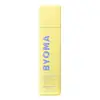What's inside
What's inside
 Key Ingredients
Key Ingredients

 Benefits
Benefits

 Concerns
Concerns

 Ingredients Side-by-side
Ingredients Side-by-side

Water
Skin ConditioningGlycerin
HumectantPropanediol
SolventDicaprylyl Carbonate
EmollientHydroxyethyl Acrylate/Sodium Acryloyldimethyl Taurate Copolymer
Emulsion StabilisingSqualane
EmollientCocamidopropyl Hydroxysultaine
CleansingButyrospermum Parkii Butter
Skin ConditioningSorbitan Oleate Decylglucoside Crosspolymer
CleansingBetaine
HumectantAvena Sativa Kernel Extract
AbrasiveSaccharide Isomerate
HumectantEthylhexylglycerin
Skin ConditioningSodium Acrylate/Sodium Acryloyldimethyl Taurate Copolymer
Emulsion StabilisingPolyisobutene
Caprylyl/Capryl Glucoside
CleansingSodium Surfactin
CleansingSorbitan Isostearate
EmulsifyingSorbitan Oleate
EmulsifyingTetrasodium Glutamate Diacetate
Citric Acid
BufferingChlorphenesin
AntimicrobialSodium Benzoate
MaskingWater, Glycerin, Propanediol, Dicaprylyl Carbonate, Hydroxyethyl Acrylate/Sodium Acryloyldimethyl Taurate Copolymer, Squalane, Cocamidopropyl Hydroxysultaine, Butyrospermum Parkii Butter, Sorbitan Oleate Decylglucoside Crosspolymer, Betaine, Avena Sativa Kernel Extract, Saccharide Isomerate, Ethylhexylglycerin, Sodium Acrylate/Sodium Acryloyldimethyl Taurate Copolymer, Polyisobutene, Caprylyl/Capryl Glucoside, Sodium Surfactin, Sorbitan Isostearate, Sorbitan Oleate, Tetrasodium Glutamate Diacetate, Citric Acid, Chlorphenesin, Sodium Benzoate
Water
Skin ConditioningGlycerin
HumectantDecyl Glucoside
CleansingCetyl Ethylhexanoate
EmollientEthylhexyl Palmitate
EmollientHelianthus Annuus Seed Oil
EmollientDiisostearyl Malate
EmollientArachidyl Alcohol
EmollientCetearyl Alcohol
EmollientPanthenol
Skin ConditioningGlucose
HumectantGlyceryl Stearate
EmollientBehenyl Alcohol
EmollientAvena Sativa Meal Extract
SoothingDipropylene Glycol
HumectantArachidyl Glucoside
EmulsifyingCeramide NP
Skin ConditioningCholesterol
EmollientCaprylic/Capric Triglyceride
MaskingTocopherol
AntioxidantHydrogenated Lecithin
EmulsifyingOryza Sativa Germ Extract
EmollientXanthan Gum
EmulsifyingHydroxyacetophenone
AntioxidantPhytosphingosine
Skin ConditioningAcrylates/C10-30 Alkyl Acrylate Crosspolymer
Emulsion StabilisingSodium Stearoyl Glutamate
CleansingCaprylyl Glycol
EmollientCitric Acid
BufferingEthylhexylglycerin
Skin ConditioningDisodium EDTA
Stearic Acid
CleansingOleic Acid
EmollientMaltodextrin
AbsorbentCetyl Alcohol
EmollientDipotassium Glycyrrhizate
HumectantAstaxanthin
Skin Conditioning1,2-Hexanediol
Skin ConditioningButylene Glycol
HumectantCocos Nucifera Fruit Extract
EmollientLactic Acid
BufferingCyanocobalamin
Skin ConditioningSodium Citrate
BufferingCaprylhydroxamic Acid
Water, Glycerin, Decyl Glucoside, Cetyl Ethylhexanoate, Ethylhexyl Palmitate, Helianthus Annuus Seed Oil, Diisostearyl Malate, Arachidyl Alcohol, Cetearyl Alcohol, Panthenol, Glucose, Glyceryl Stearate, Behenyl Alcohol, Avena Sativa Meal Extract, Dipropylene Glycol, Arachidyl Glucoside, Ceramide NP, Cholesterol, Caprylic/Capric Triglyceride, Tocopherol, Hydrogenated Lecithin, Oryza Sativa Germ Extract, Xanthan Gum, Hydroxyacetophenone, Phytosphingosine, Acrylates/C10-30 Alkyl Acrylate Crosspolymer, Sodium Stearoyl Glutamate, Caprylyl Glycol, Citric Acid, Ethylhexylglycerin, Disodium EDTA, Stearic Acid, Oleic Acid, Maltodextrin, Cetyl Alcohol, Dipotassium Glycyrrhizate, Astaxanthin, 1,2-Hexanediol, Butylene Glycol, Cocos Nucifera Fruit Extract, Lactic Acid, Cyanocobalamin, Sodium Citrate, Caprylhydroxamic Acid
 Reviews
Reviews

Ingredients Explained
These ingredients are found in both products.
Ingredients higher up in an ingredient list are typically present in a larger amount.
Citric Acid is an alpha hydroxy acid (AHA) naturally found in citrus fruits like oranges, lemons, and limes.
Like other AHAs, citric acid can exfoliate skin by breaking down the bonds that hold dead skin cells together. This helps reveal smoother and brighter skin underneath.
However, this exfoliating effect only happens at high concentrations (20%) which can be hard to find in cosmetic products.
Due to this, citric acid is usually included in small amounts as a pH adjuster. This helps keep products slightly more acidic and compatible with skin's natural pH.
In skincare formulas, citric acid can:
While it can provide some skin benefits, research shows lactic acid and glycolic acid are generally more effective and less irritating exfoliants.
Most citric acid used in skincare today is made by fermenting sugars (usually from molasses). This synthetic version is identical to the natural citrus form but easier to stabilize and use in formulations.
Read more about some other popular AHA's here:
Learn more about Citric AcidEthylhexylglycerin (we can't pronounce this either) is commonly used as a preservative and skin softener. It is derived from glyceryl.
You might see Ethylhexylglycerin often paired with other preservatives such as phenoxyethanol. Ethylhexylglycerin has been found to increase the effectiveness of these other preservatives.
Glycerin is already naturally found in your skin. It helps moisturize and protect your skin.
A study from 2016 found glycerin to be more effective as a humectant than AHAs and hyaluronic acid.
As a humectant, it helps the skin stay hydrated by pulling moisture to your skin. The low molecular weight of glycerin allows it to pull moisture into the deeper layers of your skin.
Hydrated skin improves your skin barrier; Your skin barrier helps protect against irritants and bacteria.
Glycerin has also been found to have antimicrobial and antiviral properties. Due to these properties, glycerin is often used in wound and burn treatments.
In cosmetics, glycerin is usually derived from plants such as soybean or palm. However, it can also be sourced from animals, such as tallow or animal fat.
This ingredient is organic, colorless, odorless, and non-toxic.
Glycerin is the name for this ingredient in American English. British English uses Glycerol/Glycerine.
Learn more about GlycerinWater. It's the most common cosmetic ingredient of all. You'll usually see it at the top of ingredient lists, meaning that it makes up the largest part of the product.
So why is it so popular? Water most often acts as a solvent - this means that it helps dissolve other ingredients into the formulation.
You'll also recognize water as that liquid we all need to stay alive. If you see this, drink a glass of water. Stay hydrated!
Learn more about Water